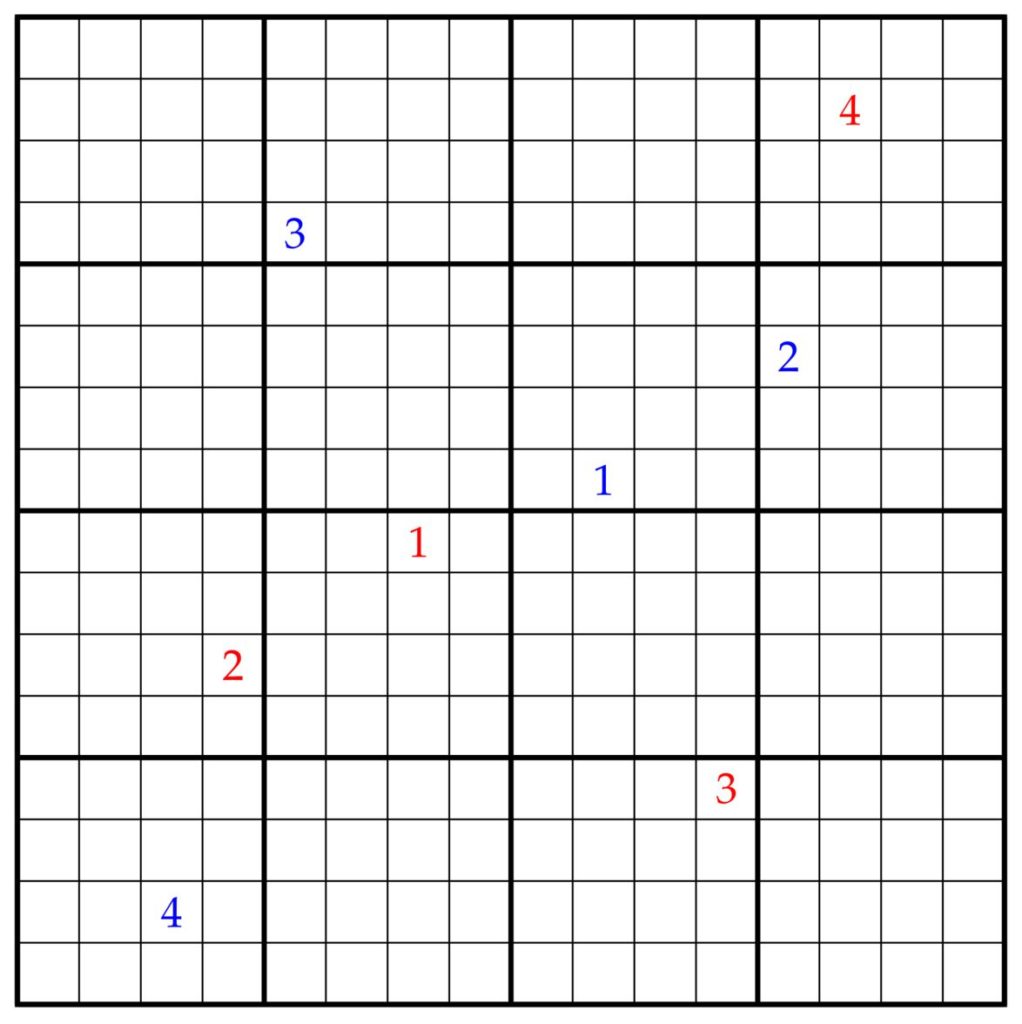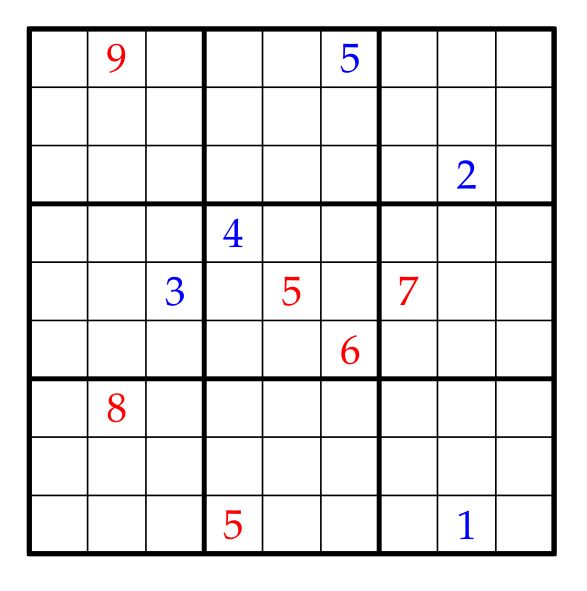Consider what I call the Sudoku game, recently introduced in the MathOverflow question Who wins two-player Sudoku? posted by Christopher King (user PyRulez). Two players take turns placing numbers on a Sudoku board, obeying the rule that they must never explicitly violate the Sudoku condition: the numbers on any row, column or sub-board square must never repeat. The first player who cannot continue legal play loses. Who wins the game? What is the winning strategy?
The game is not about building a global Sudoku solution, since a move can be legal in this game even when it is not part of any global Sudoku solution, provided only that it doesn’t yet explicitly violate the Sudoku condition. Rather, the Sudoku game is about trying to trap your opponent in a maximal such position, a position which does not yet explicitly violate the Sudoku condition but which cannot be further extended.
In my answer to the question on MathOverflow, I followed an idea suggested to me by my daughter Hypatia, namely that on even-sized boards
This argument works on even-sized boards precisely because the reflection of every row, column and sub-board square is a totally different row, column and sub-board square, and so any new violation of the Sudoku conditions would reflect to a violation that was already there. The mirror strategy definitely does not work on the odd-sized boards, including the main
After posting that answer, Orson Peters (user orlp) pointed out that one can modify it to form a winning strategy for the first player on odd-sized boards, including the main
This idea is fully general for odd-sized Sudoku boards
Conclusion.
- On even-sized Sudoku boards, the second player wins the Sudoku game by the mirror copying strategy.
- On odd-sized Sudoku boards, the first players wins the Sudoku game by the complement-mirror copying strategy.
Note that on the even boards, the second player could also play complement mirror copying just as successfully.
What I really want to tell you about, however, is the infinite Sudoku game (following a suggestion of Sam Hopkins). Suppose that we try to play the Sudoku game on a board whose subboard squares are
One thing to notice is that on an infinite board, it is no longer possible to get trapped at a finite stage of play, since every finite position can be extended simply by playing a totally new label from the set of labels; such a move would never lead to a new violation of the explicit Sudoku condition.
For this reason, I should like to introduce the Sudoku Solver-Spoiler game variation as follows. There are two players: the Sudoku Solver and the Sudoku Spoiler. The Solver is trying to build a global Sudoku solution on the board, while the Spoiler is trying to prevent this. Both players must obey the Sudoku condition that labels are never to be explicitly repeated in any row, column or sub-board square. On an infinite board, the game proceeds transfinitely, until the board is filled or there are no legal moves. The Solver wins a play of the game, if she successfully builds a global Sudoku solution, which means not only that every location has a label and there are no repetitions in any row, column or sub-board square, but also that every label in fact appears in every row, column and sub-board square. That is, to count as a solution, the labels on any row, column and sub-board square must be a bijection with the set of labels. (On infinite boards, this is a stronger requirement than merely insisting on no repetitions.)
The Solver-Spoiler game makes sense in complete generality on any set
Upon reflection, one realizes that what matters about
What I claim is that the Solver has a winning strategy in the all the infinite Sudoku Solver-Spoiler games, in a very general and robust manner.
Theorem. For every infinite cardinal
- The strategy will win in
- The Solver can win whether she goes first or second, starting from any legal position of size less than
- The Solver can win even when the Spoiler is allowed to play finitely many labels at once on each turn, or fewer than
- In the countably infinite Sudoku game, the Solver can win even if the Spoiler is allowed to make infinitely many moves at once, provided only that the resulting position can in principle be extended to a full solution.
Proof. Consider first the countably infinite Sudoku game, and assume the initial position is finite and that the Spoiler will make finitely many moves on each turn. Consider what it means for the Solver to win at the limit. It means, first of all, that there are no explicit repetitions in any row, column or sub-board. This requirement will be ensured since it is part of the rules for legal play not to violate it. Next, the Solver wants to ensure that every square has a label on it and that every label appears at least once in every row, every column and every sub-board. If we think of these as individual specific requirements, we have countably many requirements in all, and I claim that we can arrange that the Solver will simply satisfy the
The argument works equally well no matter who goes first or if the Spoiler makes arbitrary finite play, or indeed even infinite play, provided that the play is part of some global solution (perhaps a different one each time), since on each move the Solve can simply meet the requirement by using that solution at that stage.
An essentially similar argument works when
I find it interesting to draw out the following aspect of the argument:
Observation. Every finite labeling of an infinite Sudoku board that does not yet explicitly violate the Sudoku condition can be extended to a global solution.
Similarly, any size less than
What about asymmetric boards? It has come to my attention that people sometimes look at asymmetric Sudoku boards, whose sub-boards are not square, such as in the six-by-six Sudoku case. In general, one could take Sudoku boards to consist of a
In the finite
In the case
Finally, let’s consider the Sudoku Solver-Spoiler game in the purely finite case, which actually is a very natural game, perhaps more natural than what I called the Sudoku game above. It seems to me that the Spoiler should be able to win the Solver-Spoiler game on any nontrivial finite board. But I don’t yet have an argument proving this. I asked a question on MathOverflow: The Sudoku game: Solver-Spoiler variation.




